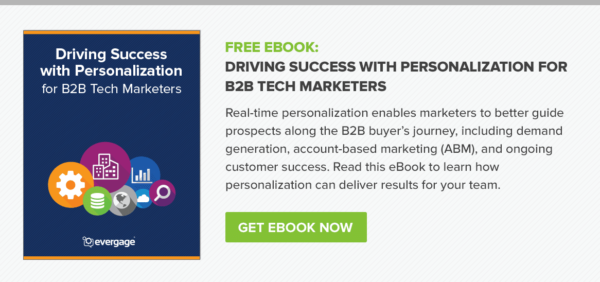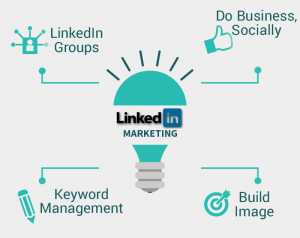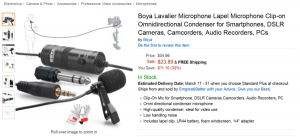— February 9, 2018
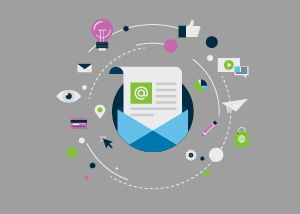
Email personalization isn’t new to most digital marketers — many have been personalizing their emails for years. In fact, we found that email remains the most personalized channel. However, we often find that many marketers who personalize their emails are only using basic tactics like personalizing the email message or subject line with someone’s name, company, industry, etc. This level of personalization is a good start, but it’s a far cry from the type of one-to-one personalization that can really have an impact on B2B software buyers and application users.
A recent Wall Street Journal article called marketers out for not meeting consumer expectations. It notes that many consumers are experiencing email overload — and they find the majority of the emails they receive irrelevant. They are frustrated and want marketers to change. (While the article references retailers specifically, don’t forget that your business buyers are consumers too!)
To explain the importance of sending triggered emails — rather than traditional “batch and blast” campaigns — and provide tips and use cases across industries, Megan Knisely and T.J. Prebil, Customer Success Manager and Director of Product Marketing respectively, recently presented a webinar entitled “Boost Engagement and Clickthroughs with Triggered Emails.” In this blog post, I’ll cover some of the interesting use cases they shared that are relevant to B2B SaaS marketers and product managers, but be sure to watch the full webinar replay for more detail.
What are triggered emails?
Before we get into the use cases, let’s briefly cover what qualifies as a triggered email. Unlike traditional emails where the send time is set by the marketer and the audience is a large group of people, triggered emails are sent to individuals on a one-off basis and only when certain criteria are met. Using triggered emails is similar to using rule-based personalization on a website. With rule-based personalization, you can display a message or experience once a visitor qualifies for it with “IF/THEN” statements (such as: IF a visitor has been on the site for more than two minutes, THEN display a message asking if he needs help). You take a similar approach with triggered emails. Of course, the IF/THEN logic can be more sophisticated to target narrower segments with highly relevant messaging.
Some reasons you may trigger an email are:
- A person takes an action (or fails to take an action) on your site or in your app
- External conditions (such as the weather)
- Catalog updates (such as new products or new content is added)
So for example, IF a person who downloaded a white paper about web security has not returned to your site in the past week AND no activity has been logged by a sales rep for this lead in your CRM, trigger an email containing your latest or most relevant content on web security.
This is an actual (and good) example use case for triggered email for SaaS marketers. Now let’s explore additional use cases for SaaS companies.
Lead notifications
According to SiriusDecisions, 67% of the buyer’s journey is done digitally. In order to effectively communicate with prospects in digital channels, B2B marketers must be able to recognize where each account falls in its research journey and provide relevant content. For example, if four people from one account all visited your site within the past two days, you can assume that the account is actively researching solutions.
If you have the email addresses of some of those visitors (assuming they clicked through on a prior email or have filled out a form on your site), you can trigger an email containing relevant content recommendations related to their industry or area of interest.
Internal email opportunity: After you send a triggered email to the prospect (or even if you don’t as you may not yet have their email addresses), you can also send a triggered email internally to relevant stakeholders. For example, you can send a triggered email to a salesperson to alert her of the account’s activity. This allows her to provide personalized outreach, timed at the moment the account would likely be receptive to her.
New content
Newsletters sent to clients and prospects are a common tactic for B2B marketers, but if they are sent too frequently with irrelevant content, recipients may unsubscribe or start to ignore the emails.
If you have a lot of new content that you’d like to push out to newsletter subscribers, you can consider setting up your newsletter to trigger at the right moment instead. With this approach, the emails will be sent as soon as you have generated enough relevant content for each person (in their preferred topics or categories that they have not already read) — so that each newsletter contains new and relevant information.
Onboarding
Once a prospect becomes a customer, they will need to be onboarded with your SaaS solution. If a user completes the required onboarding steps, an email can be triggered to suggest next steps to take. Or, if she fails to complete the onboarding steps within a certain time window, she can be sent a triggered email to remind her which steps she still has to complete.
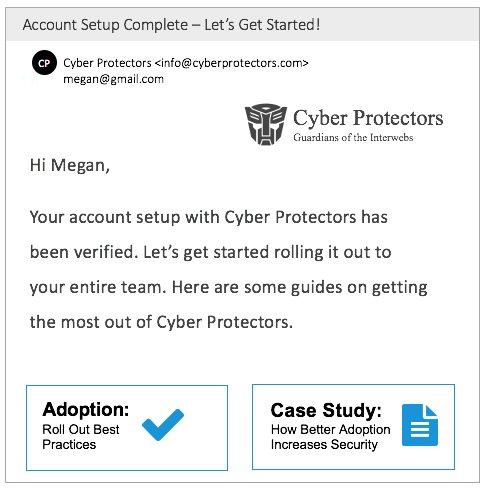
Activity changes
Activity changes within the product can also be a good opportunity to reach out to a customer via triggered email. Let’s say that a customer consistently logs into your application at least once a week but then stops logging in for an extended period of time. It may be a good moment to reach out with a clever email to re-engage him or inquire about any issues he may have encountered.
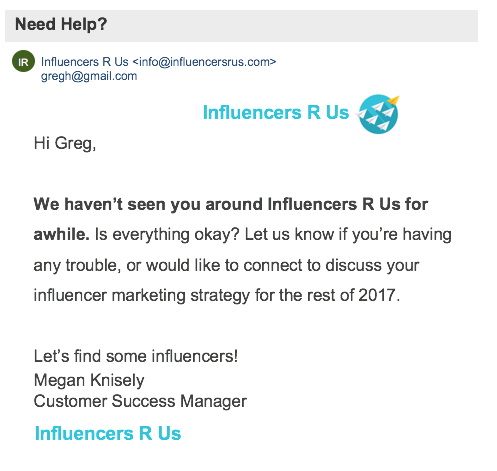
Of course, you can also reach out when a customer begins using your product more than usual. For example, if he begins logging in more frequently or using more features, you can send him a triggered email asking if he may want to upgrade to a higher plan level or schedule a call with a representative.
Internal email opportunity: It may also be a good time to send an internal email to the user’s account manager or customer success manager alerting her to his activity change. She may want to reach out to him personally and proactively to ensure that he is still happy with the service (if he has stopped using the product) or if he would like to upgrade (if his activity increased).
Churn notifications
Tracking the behaviors taken within your app can help you spot customers that are about to churn. For example, customers who view your cancellation policy page may be showing intent to leave. There could be other clear indicators that a customer is about to churn as well. You can trigger off these behaviors to send supportive emails or even special offers to encourage retention.
Internal email opportunity: You can use triggered emails to alert your customer success team of potential churn risks. They may be able to act quickly to save the account.
Final Thoughts
Remember that triggers can include actions taken or not taken, external conditions, or updates to your product or content catalog. And triggered emails aren’t just for prospects or customers — send triggered emails to internal employees alerting them of important behaviors taken by their target accounts or customers.
This blog post has described some triggered email use cases for SaaS companies, but there are more described in the webinar replay. Be sure to watch it today!
Digital & Social Articles on Business 2 Community
(79)

